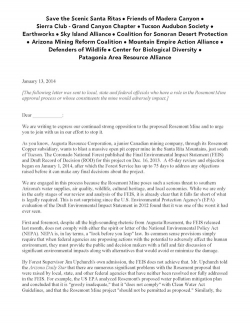Rosemont Environmental Letter
Published: January 13, 2014
By: Earthworks et. al.
We are writing to express our continued strong opposition to the proposed Rosemont Mine and to urge you to join with us in our effort to stop it.
As you know, Augusta Resource Corporation, a junior Canadian mining company, through its Rosemont Copper subsidiary, wants to blast a massive open pit copper mine in the Santa Rita Mountains, just south of Tucson. The Coronado National Forest published the Final Environmental Impact Statement (FEIS) and Draft Record of Decision (ROD) for this project on Dec. 16, 2013. A 45-day review and objection began on January 1, 2014, after which the Forest Service has up to 75 days to address any objections raised before it can make any final decisions about the project.
We are engaged in this process because the Rosemont Mine poses such a serious threat to southern Arizona's water supplies, air quality, wildlife, cultural heritage, and local economies. While we are only in the early stages of our review and analysis of the FEIS, it is already clear that it falls far short of what is legally required. This is not surprising since the U.S. Environmental Protection Agency's (EPA) evaluation of the Draft Environmental Impact Statement in 2012 found that it was one of the worst it had ever seen.
First and foremost, despite all the high-sounding rhetoric from Augusta/Rosemont, the FEIS released last month, does not comply with either the spirit or letter of the National Environmental Policy Act (NEPA). NEPA is, in lay terms, a "look before you leap" law. Its common sense provisions simply require that when federal agencies are proposing actions with the potential to adversely affect the human environment, they must provide the public and decision makers with a full and fair discussion of significant environmental impacts along with alternatives that would avoid or minimize the damage. By Forest Supervisor Jim Upchurch's own admission, the FEIS does not achieve that. Mr. Upchurch told the Arizona Daily Star that there are numerous significant problems with the Rosemont proposal that were raised by local, state, and other federal agencies that have neither been resolved nor fully addressed in the FEIS. For example, the US EPA analyzed Rosemont's proposed water pollution mitigation plan and concluded that it is "grossly inadequate," that it "does not comply" with Clean Water Act Guidelines, and that the Rosemont Mine project "should not be permitted as proposed." Similarly, the
US Bureau of Land Management, the Arizona Department of Environmental Quality, Pima County and others have raised serious concerns about the Mine's impacts to Las Cienegas National Conservation Area, Cienega Creek, and Davidson Canyon. Cienega Creek and Davidson Canyon have been designated as "Outstanding Waters" by the State of Arizona and, by law, their water quality cannot be degraded.
This proposed mine would destroy an area of internationally significant biodiversity. It contains nine federally threatened and endangered species including the only known living jaguar in the US. Recent reports indicate that 300,000 trees will be cut down to make way for the mine. While it was reported that the Forest Service hopes to have those myriad problems resolved via “mitigation” over the next four months before a final decision is issued, it is clear that NEPA's requirements have not yet been met.
Moreover, the project does not meet - nor can it meet - the requirements of other state and federal laws designed to protect southern Arizona's water supplies, wildlife, and air quality, let alone avoid severe impacts on recreation and dark skies or to prevent severe reductions in property values for area residents and businesses.
In addition, it is important to recognize that none of the 12 tribal nations and communities that were included in the consultation required by Federal law signed the Section 106 Memorandum of Agreement. In other words, all of them have come to the conclusion that this project would, to quote Chairman Ned Norris of the Tohono O’odham Nation, “irrevocably alter the cultural landscape of Ce:wi Duag (Santa Rita Mountains).”
Our analysis of the FEIS will continue over the next eight weeks as we participate in the Forest Service's formal objection process. We will share with you the analysis and documentation that we submit to the Forest Service at that time.
Last, but not least, we remain committed to ensuring that our environment, economies, and cultural heritage are not jeopardized by this short-sighted mining proposal, a project that would primarily enrich a handful of foreign investors at the expense of those of us whose lives and livelihoods would be jeopardized by the mine's depletion of precious groundwater supplies and its pervasive and round-theclock water, air, noise, and light pollution.
We urge you to join us in working together to oppose and stop this misguided project.

Follow Earthworks